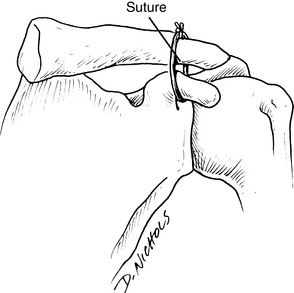Acromioclavicular Separation, Surgery for
Indications: who needs surgery, when and why, and goals
• Athletes with some types of severe sprains require surgery to restore the normal relationship of the collarbone to the shoulder and to reduce the drooping of the shoulder.
• Contact athletes are usually treated nonoperatively with a sling until the pain recedes, allowing for a more rapid return to sports. This is due to the prolonged convalescence and rehabilitation after surgery and the likelihood of recurrent injury with contact sports.
• Patients with continued pain after nonoperative management—including 3 months or more of physical therapy, antiinflammatory medications, and activity modification—are also candidates for surgery.
Contraindications: reasons not to operate
• Because synthetic material or screws may be used to temporarily or permanently hold the collarbone while the ligament grows into it, infection is a contraindication to surgery.
• Previous surgery in which a large amount of the end of the collarbone has been removed may make it impossible to perform the surgery.
• Surgery for acromioclavicular (AC) separation often uses the ligament between the acromion and coracoid process; thus anyone who has had previous surgery to this ligament, such as for a subacromial decompression or rotator cuff surgery, and anyone who has had previous surgery to the AC joint may not be a candidate for this operation.
Risks and complications of surgery
• Infection, bleeding, injury to nerves (numbness, weakness, paralysis) of the shoulder, arm, forearm, and hand
Postoperative course
• You may feel more comfortable sleeping sitting up on a couch or recliner for the first 1 to 2 weeks after surgery.
• Keep your arm in a sling, usually for 6 weeks or until after the screw or pin is removed from the shoulder.
Return to sports
• Return to sports depends on the type of sport, position played, and the arm injured (dominant versus nondominant).
When to call your doctor
• Any of the following occur after surgery: increased pain, swelling, redness, drainage, or bleeding in the surgical area.
• Signs of infection appear, such as headache, muscle aches, dizziness, or a general ill feeling with fever.
Stay updated, free articles. Join our Telegram channel

Full access? Get Clinical Tree







